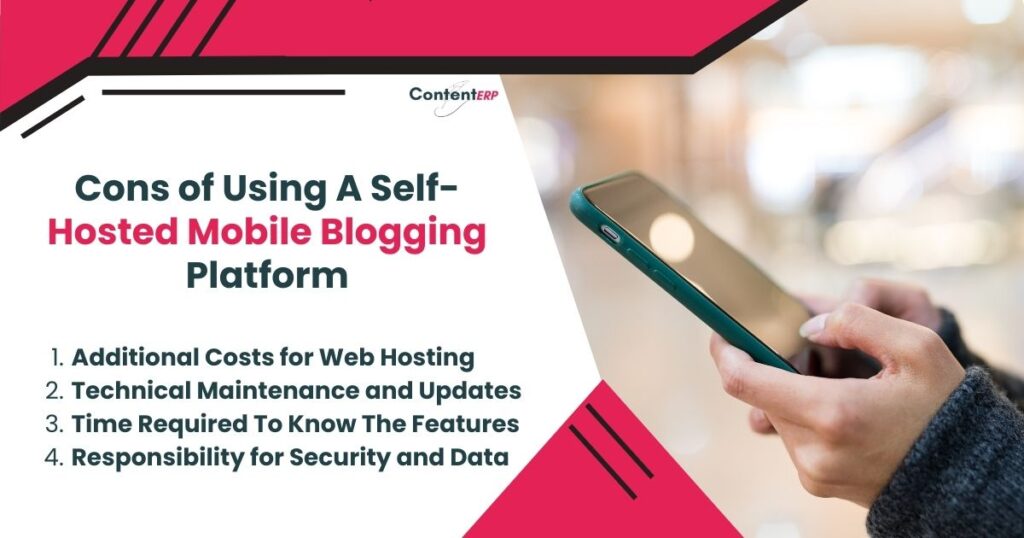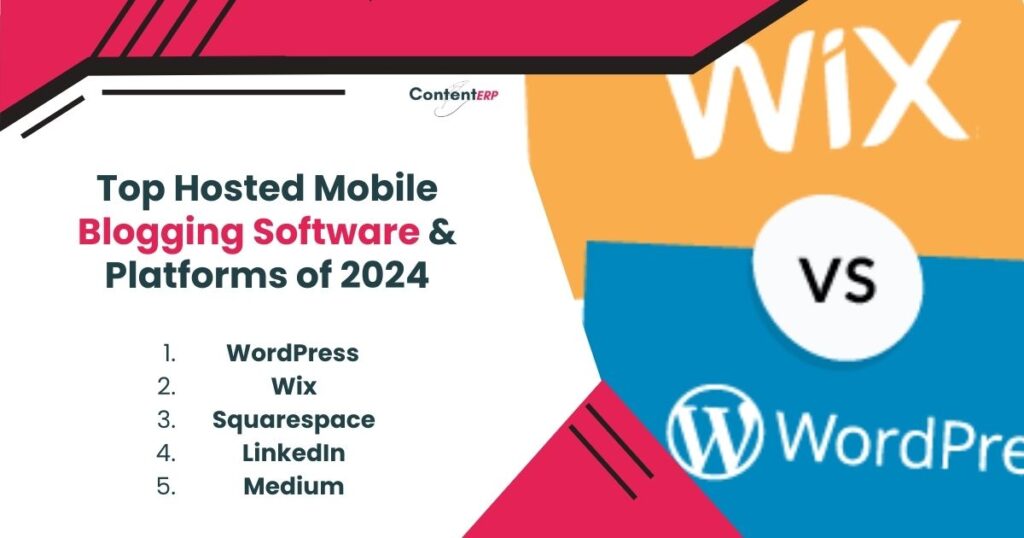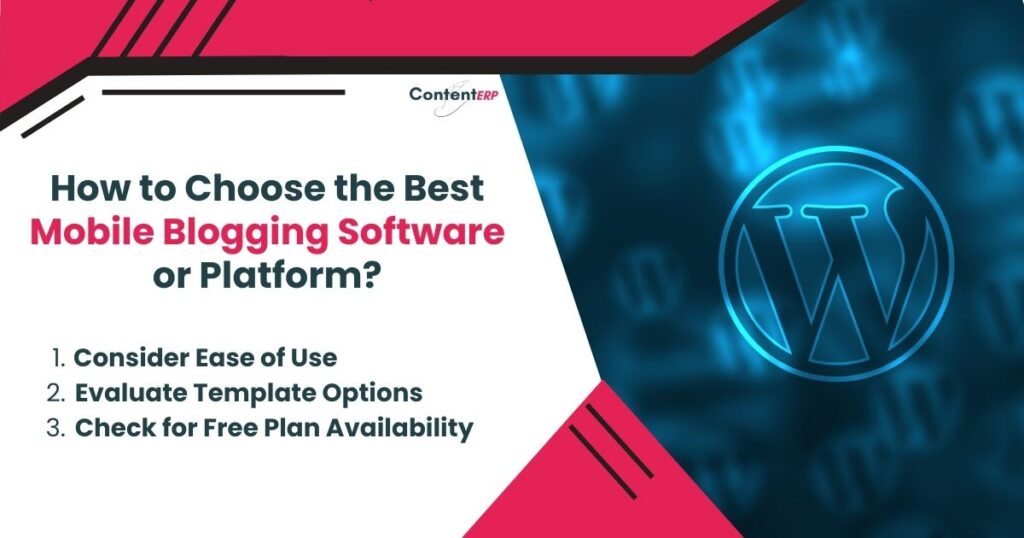“Content is where I expect much of the real money will be made on the internet.” Bill Gates wrote this prophetic statement in an essay in 1996, almost 26 years ago – and this has now spectacularly unfolded and come true in our digital world. But what even he couldn’t foresee was how quickly our world will shift towards mobile-friendliness in content creation – especially blogging. So is all this hype about the mobile blogging software truly worth it?
These mobile blogging software and platforms are where your convenience will meet your creative spirit. Though they come with the flexibility to draft, edit and even publish the content directly from your smartphone, they also have a set of considerations and even cons that you simply shouldn’t miss looking at.
Join us in this blog to learn more about the pros and cons of mobile blogging software and how they might just be the thing you never knew you needed.
What are the Key Features of Mobile Blogging Software & Platforms?
These mobile blogging platforms or digital notepads as we like to call them, have evolved generously over time to give you more options, convenience and also indepth insights. And why shouldn’t they when around 60% of searches are now coming from mobile devices.
But what exactly makes them so useable and beneficial for bloggers like you and what do most of them provide you on the go?
Here are some of the most common features that make them stand out.
Drag-and-Drop Interface
There was a time when every piece of content that you had to upload required some complex coding, which naturally translated to spending more time, skills and efforts. But today’s mobile blogging platforms offer you simple-to-use drag and drop interfaces to arrange your text, images and multimedia content with just the flick of your finger. No complex coding anymore.
This simplicity has now allowed the bloggers to design their blogs as they like, no matter what their skill levels are.
Customization Options
For your blog to stand out in this competitive digital world, it has to have a separate identity, one that makes it unique and individually yours. According to HubSpot, the content you have personalized will perform 42% better than non-personalized content.
Today’s mobile blogging software have recognized this requirement and hence offer you a lot of customization options to make sure you can set up your blog to match your personal or brand identity.
Themes, widgets, plugins and whatnot, you will be able to use them all to make your blog match your own aesthetics and vision.
Integration with Google Analytics
The success of your blog can only be determined on the basis of the insights and metrics Google Analytics provides you. It serves as a bridge between your blog and the behavior and preferences of your audience. Most of the mobile blogging software have added this Google Analytics feature that will allow you to track visitor engagement, page views, demographics and even the bounce rates.
With this data, you can then customize your content strategy to meet the needs of your audience and optimize your blog to increase its engagement and as a result create more loyal followers.

How to Choose the Best Mobile Blogging Software or Platform?
When the time comes to choose a mobile blogging software, you’ll feel like choosing a new coffee shop to be your next favorite spot. You would want something that’d make you feel welcome, sparks the creativity in you and also as a most important feature, does not complicate the process of content creation or upload more than it needs to be.
So how would you choose a platform for mobile blogging to reach out to more than 5.4 billion people who can access the internet?
Here’s what you should always look for before making your ultimate choice:
Read More: How to Create a Digital Brand Strategy for Optimal Growth
Ease of Use: This Is Your First Milestone to Success
You should look for a platform or software that gives you an ease of use and has a very user-friendly interface. Every new content should be uploaded with ease. Some features that you should never compromise on are a straightforward content editor, a quick access to support (if you ever need it) and an interface that’s less cluttered and easy to understand quickly.
Why It Matters: A recent research has shown that customers are usually more loyal and satisfied towards softwares that exhibit an ease of use and a friendly interface. If it constantly feels like you have to battle with the interface every time you upload a blog, chances are you are less likely to keep your blog updated. Hence, your digital presence will be affected.
How To Test It: Before you finalize any platform, try to take advantage of the free trial if available. Write a demo post and check out all the editing tools. If they don’t feel like you are solving a puzzle or finding your way out through a maze, check this box.
Template Options: Follow Your Brand Identity & Mobile Responsiveness
The next feature to look for in mobile blogging software should be the templates it offers. Select the one that offers a large variety to choose from. More specifically, see if the platform has any templates that exactly match your identity or brand’s persona.
In addition to that, those templates should also be responsive, which means they should be able to change their UI based on the device they are being viewed from.
Why It Matters: Templates that don’t match your blog’s content or your identity may not be able to attract more readers due to the obvious conflict or inconsistent branding. Plus, Google is now going to follow mobile-first indexing so your blog has to look good on mobile devices as well with responsive designs.
How To Test It: Written a blog already? Plug it in and preview it in all the templates that you see fit for your brand. This is the best way to know whether a template makes your blog shine or takes it down the drain.
Free Plan Availability: Make It Your Low-Risk Starting Point
This is especially for you if you are just going to start a blog. You should not have to pay to play right in the beginning. So the next feature you should consider is pricing. A platform or software with a free plan will help you start your dream without any financial pressure.
Why It Matters: A free plan on any mobile blogging software will help you invest more in your content creation and less in just building the interface which comes lower in the priority list of SEO rankings.
How To Test It: You should understand that there are certain limitations that come with free plans. How much storage you’ll get? Can you remove the platform branding from your uploaded blogs? Know what you are working with even with the platforms that don’t charge initially.

Make The Right Choice – Choose The Best Mobile Blogging Software
All of this comes down to your brand’s identity and your preferences. Try to find a balance between user-friendliness, the ability to show your style and the freedom to grow your blog without spending thousands. The platform you choose should be a place where you feel confident to share your thoughts with the world and not a burden that you carry with disdain.
Read More: 6 Benefits of Outsourcing SEO Services in 2024 You Can’t Ignore
Pros and Cons of Using Self-Hosted Mobile Blogging Platforms
In your treasure hunt to find the best blogging platform, one path leads to the world of self-hosted mobile blogging platforms. Self-hosting is a practice where you run and maintain your own website using a private web server instead of using a third-party service.
If you are not able to find a good hosted platform, then a self-hosting mobile platform may be the best choice for you due to various benefits that simply outgrow as compared to the hosted platforms.
So here is a quick overview of the pros and cons of going self-hosted.
Pros of Using A Self-Hosted Mobile Blogging Platform
Full Control over Content Management System
To have your own space on the internet feels empowering, right? And rightly so, because with a self-hosted blogging platform, you become the captain of your own ship. You get to decide how your blog operates, you choose your own plugins, you code everything yourself and you select the interface.
This kind of autonomy will allow you to customize it to improve your blogging experience with each tool and feature. You will have full control over the content management system and be able to modify it however you like.
Potential Search Engine Optimization Benefits
“Visibility equals opportunity,” as the old digital marketing saying goes. That is exactly what the self-hosted platforms offer – a goldmine of SEO advantages. The hosted platforms are limited and have a lot of constraints one of which is not being able to optimize its backend.
With a self-hosted platform, you can develop the backend of your site yourself and then optimize it for search engines in ways that were previously unimaginable. You can customize your permalink structure, improve your website speed and even access the advanced SEO plugins to help you take your blog’s visibility to the top of Google’s rankings.
Custom Branding and Domain Freedom
Imagine your blog as your own digital real estate you have on the internet. In the self-hosted world, you will have the freedom to construct it as you see fit. You can implement a custom branding that makes your blog unmistakably yours and only yours. And with custom themes and a unique domain name will give you the ability to stand out in the crowded blogosphere. These benefits are simply invaluable.
To be able to choose a custom branding and domain names will make your blog a proper landmark of your niche or business.
More Scalability and Flexibility
As your blog grows, so too will your ambitions. Self-hosted platforms are the fertile soil in which the seeds of your blog can sprout and expand without any limitation at all.
You want to integrate an online store? Go ahead. Wanna add forums or expand into multimedia content? Be your own guest. Your platform will scale with you. This scalability will help you make sure that the sky’s the limit for what your blog can become and offers the flexibility to evolve as your audience and content strategy grow together.
Enhanced Security and Backup Options
This is an era where digital security is everything. So being able to have a control over your blog’s security is an opportunity that should be grabbed with both hands. Self-hosted platforms allow you to introduce advanced security measures with specific plugin installations. Some services even provide comprehensive backup solutions.
This control means you can protect your content and your readers’ information from digital threats and offer them a peace of mind in the unpredictable online world where scamming and phishing have now become rampant.

That’s it with the benefits, now let’s know about the disadvantages as well.
Cons of Using A Self-Hosted Mobile Blogging Platform
Additional Costs for Web Hosting
“Everything has its price,” as the saying goes. And in the world of self-hosted blogging, this couldn’t be truer. For all the hosted platforms, hosting is part of the package when you sign up with them. But with self-hosting, you’re on your own with web hosting costs.
These can vary widely and mostly depend on the hosting provider and the level of traffic your blog usually receives on average. The average cost of web hosting ranges from $2.95 to $24.95 per month and this price depends on the provider and services you have chosen.
One thing to note is that your budget will not only include the initial costs but the potential increases as well as your blog grows with time.
Technical Maintenance and Updates
When you start your self-hosted blogging journey, you’ll also sign up to be the caretaker of your site. This will include regular maintenance, updates and then troubleshoot any issues that come up. No doubt this gives you total control but it also demands a level of technical knowledge or at least the ability to learn.
For some, this can be a rewarding challenge; for others, a hurdle. It’s up to you how you’d handle this technicality.
Time And Efforts To Learn About Features
“Knowledge is power,” Francis Bacon had stated and with self-hosted blogging platforms, this can sometimes come with a learning curve.
You’ll have to understand the backend of a website, know about the SEO details and also select the themes as per your brand identity. All of this will require your time and effort.

Responsibility for Security and Data Backups
With great power comes great responsibility. This particularly comes into effect when it comes to the security of your website and the safety of your readers’ data. Self-hosted platforms don’t have any inbuilt security features so you’ll have to implement security measures yourself and make sure that data is being backed up regularly.
One slip can set your website and blog way back if you don’t stay vigilant. This responsibility can become a significant concern especially now when digital threats are ever-present and are getting stronger.
Read More: How to Create the Best Business Plan for Content Creators
Monetization Options on Mobile Blogging Platforms
“Do what you love, and the money will follow.” Marsha Sinetar basically couldn’t have said it better especially for the bloggers in our digital world. This is what your ultimate should be, to turn your passion into profit. Let’s know about the avenues through which you can make your blog a very profitable venture.
1. Explore Affiliate Marketing Strategies
Affiliate marketing is where you use the product recommendations in your blog’s narrative in a way that feels natural and genuine. You match the products you love and use them with the content your audience values.
When a reader clicks on one of your affiliate links and makes a purchase, you earn a commission – the process is that simple. Affiliate marketing is simple, relevant and helps make a lot of money if you do it right. In US alone, affiliate marketing is going to hit at least $8 billion by the end of 2024. Huge potential, right?
To go with affiliate marketing, you should join affiliate programs that match your blog’s niche. But you have to be transparent with your audience, let them know how you intend to use affiliate marketing and then integrate those links into your content.
2. Use Advertising Networks
With ads, you can turn your blog into an advertising panaflex and earn every time somebody clicks on them while reading your content. Advertising networks such as Google AdSense, let you set up the ads into your blog.
The best part here is that they find the advertisers while you provide the space. The challenge here is how you’ll be able to balance your ad placement with user experience to make sure that your blog remains reader-friendly.
3. Offer Sponsored Content
Sponsored content makes storytelling meet marketing. You can make money this way if your blog brings in significant traffic every month. Companies then pay you to write articles, reviews or features about their products or services which are then posted on your blog.
This monetization strategy is great to earn quick bucks but you should always maintain a balance between your actual voice, authenticity and marketing the product.
The best way to do it is to partner with brands that resonate with your audience. Sponsored content can help you boost your blog’s revenue significantly.
4. Create and Sell Digital Products
Your expertise and creativity can help you earn via your blog as well. The answer is; selling digital products. eBooks, online courses or downloadable guides, such content that explores the depths of your niche can open new revenue streams for you.
The key to success in digital products is to understand the needs of your audience first and then come up with solutions that address those needs. So when you promote these products through your mobile blogging platform, it will ultimately improve your blog’s value as well.

Comparing the Top Hosted Mobile Blogging Software & Platforms of 2024
Which mobile blogging software or platform you want to choose will ultimately depend on which features you prefer to have in your blog’s journey. And choosing the right hosted platform will eventually become the key reason for the success of your blog.
Let’s go through the best mobile blogging platforms of 2024 that can help you take your blogging experience to the next level with their unique features and benefits.
1. WordPress
Best For: Bloggers, especially if they want complete control and lots of customization options.
Features & Interface: WordPress says that it constitutes about 36% of the web. That’s how popular it is. What makes it even more special is that you don’t need a domain name or hosting to start. Simply sign up and choose your blog’s name. In regards to its features, you will get an unlimited bandwidth, password protection, dozens of themes and SEO friendly content structure.
It also has a plugin store with an extensive plugin collection that will help you add almost any functionality to your blog.
Pricing: WordPress.com platform is free. However, if you want your own .com domain without any ads, you’ll need to pay for web hosting. The Starter Plan is $4 per month with a custom domain name and 6 GB storage.
Ease of Use: You’ll have to learn how to add themes, switch between editors and how to get a few other tasks done especially if you are new to website management. However, the interface is not that difficult and you’ll be able to upload your first blog with ease right away.
Android App Link: WordPress Android
iOS App Link: WordPress iOS
2. Wix
Best For: Creative people who want design freedom without any complex codes or technicalities.
Features & Interface: Wix is a very decent blogging platform that goes above and beyond with its drag-and-drop interface and makes website designing an extremely simple process for everyone. It has some of the most visually stunning templates that have been customized to match different niches.
What’s more, you can further edit/change them as per your needs to make sure your blog looks exactly how you want it to be.
You can visit this link to start your blog and sign up via your Facebook or Google account as well. Its features include a drag-and-drop website builder, monetization (however, this feature is for paid plans only) and up to 500 MB of data with the most basic plan.
Pricing: Wix offers a free plan for blogging with a Wix-branded domain and ads. Website plans start with the basic level at $4.5/month where you can simply connect your domain and create your website with Wix’s templates. Other plans have more features that include ads removal, free domain for 1 year and custom domain connections.
Ease of Use: It’s an exceptionally user-friendly blogging platform and is especially for you if you prioritize design and simplicity over technical control. However, the content editor does not have the drag-and-drop ability.
Android App Link: Wix Android
iOS App Link: Wix iOS
3. Squarespace
Best For: Bloggers and small business owners. Best for you if you want to set up a blog with a simple design and straightforward functionality.
Features & Interface: Squarespace is usually known for its beautiful, designer-quality templates and clean and intuitive interface. It is already a hosted service so you won’t need a server or domain name. Squarespace has built-in tools for SEO, social media integration and e-commerce capabilities along with content scheduling and multiple users.
It also provides the ability to send email campaigns and gives you a comprehensive performance feedback with its site analytics.
Pricing: Squarespace has no free plans, sadly. But its premium plans start from $23/month and offer different features and the scale you need, but it has a 14-day free trial as well.
Ease of Use: Squarespace is very user-friendly. Simply sign up and pick a design to start your blog. A simple interface means you don’t have to make a fuss with plugins or external tools.
Android App Link: Squarespace Android
iOS App Link: Squarespace iOS
4. LinkedIn
Best For: Professionals, business people.
Features & Interface: LinkedIn’s blogging platform integrates directly into its social network. This makes LinkedIn stand out from the rest and gives you a way to publish articles directly to your professional network. However, on the downside, it does not have all those customization options that other dedicated mobile blogging software or platforms have.
LinkedIn blogs are absolutely killers are growing your network and to build an industry awareness about any of your products.
On the downside, the blogging interface does not give you the SEO benefits so no optimization options.
Pricing: Free to use. You just have to create your LinkedIn account.
Ease of Use: Incredibly straightforward. No fuss at all with content creation. A simple editor and interface will let you do everything you want with your content.
Android App Link: LinkedIn Android
iOS App Link: LinkedIn iOS
Read More: 5 Secrets to Create an Irresistible Blog Content Calendar
5. Medium
Best For: Mainly for writers. Should be your top choice if you want to engage your audience while using a straightforward platform.
Features & Interface: Medium is kind of like a social platform. It has a clean and distraction-free interface that makes you focus your energy on writing and reading only. However, you won’t get any personal branding or design options but on the upside, it has a built-in audience that may be eager to know about your stories and insights.
It has a rich editor and provides unlimited bandwidth. You can also monetize your blog if you are a part of Medium Partner Program. Simply start blogging by signing up with your Google, Facebook or Twitter account.
Pricing: Free to publish. But you’ll have to sign up for a partner program to earn money for engagement.
Ease of Use: Perhaps the most straightforward platform if you just want to write and engage with a community. Medium helps you avoid all the complexities of website management.
Android App Link: Medium Android
iOS App Link: Medium iOS
So now we know which platforms may be the best choice for your blogging needs, now we come to another and equally crucial part – making sure that your content finds its way to readers. So how would you drive traffic towards your content? Let’s find out.

How to Effectively Drive Traffic to Your Mobile Blog?
This part of the blogging journey is what requires your utmost efforts and right strategies if you want to make your writings rewarding and effective. Here’s how you can drive traffic towards your blog using your preferred mobile blogging software:
Implement SEO Strategies To Increase Visibility
The digital world is a sea of content and you have to have a lighthouse of your own to guide the readers towards your own website. Hence, to make the search engines find your blog and rank your content, you’ll have to SEO optimize it first. The top 3 results get 55% of all the clicks, hence SEO is a crucial part of your blogging journey.
- Keyword Research: Identify and use keywords into all of your blog posts. They should be relevant to your topics.
- Mobile Optimization: In 2023, mobile devices made up 59% of global website traffic. So make absolutely sure that your blog is responsive and mobile-friendly for the audience who use cell phones.
- Quality Content: Create valuable and informative content. It should directly address you’re the needs of your audience.
Use Social Media Marketing Tools
Social media is a marketplace where you can find a lot of ideas and content all around. You can use the right techniques to sell your blog and make it shine brightly.
- Choose the Right Platforms: Try to focus only on social networks where your target audience is active. If any of the platforms is not bearing fruit, quickly move on to another without wasting any time.
- Engage Your Audience: To stay relevant in the rankings, you have to post regularly. Also interact with your followers as much as you can to build a community.
- Share Visually Appealing Content: Images and videos are the new norm, so use them to increase your post engagement and shares.
Go For Guest Blogging and Collaborations
Neil Patil says that you’ll earn $6.5 for every dollar you spend on influencer marketing. Guest posting on your favorite and reputable blogs in your niche will help drive traffic back to your website via the backlinks and make your blog earn more. And not only that, it also helps increase your credibility in your field.
- Expand Your Reach: Write guest posts for other blogs in your niche to attract a new audience.
- Collaborate with Influencers: Work together with other influencers to create content This will attract their followers towards your own content.
Write Engaging Content and Use Interactive Features
Lastly, remember that you have to create compelling content to drive traffic. And if the content is attractive, it will compel your readers to interact with your content. Here’s how you can increase it:
- Use Interactive Elements: Use quizzes, polls and infographics. This will make your content more engaging.
- Encourage Comments and Feedback: Invite your readers to your content every time you publish your blog post to share their honest thoughts and suggestions.
- Update Content Regularly: Keep your blog fresh and interesting. You can do it by consistently adding new posts or updating the previous ones.

FAQs
Can I do blogging from mobile?
Absolutely and now probably more than ever as over 60% of web traffic is from mobile devices. To make use of such an opportunity, many mobile blogging platforms like Medium and WordPress have their Android and iOS apps that make it easy for you to blog directly from your phone.
What is the best app to start a blog?
WordPress and Blogger apps would be a great starting point for you if you prefer comprehensive features and ease of use for your blogs.
Which mobile app is free for blogging?
Blogger and WordPress offer free versions that are perfect to build your blog if you are a beginner.
What blog platform has the most traffic?
WordPress is among the best and most extensively used mobile blogging software that is free to use. You simply have to sign up to start using it.
Does my blog need a domain name?
It’s not something that’s strictly necessary to build a blog. However, a custom domain name would definitely improve your overall professionalism and brand identity.
Which mobile blog platform is best for making money?
WordPress.org (the self-hosted version) gives you a flexibility to monetize your blog content with different options like ads, affiliate marketing and product sales. It also has the ability to integrate many payment platforms.
What is the best free blogging platform for beginners?
Blogger and WordPress are the best choice for beginners to create their own blogs. Both of them are user-friendly and introduce the newcomers to blogging fairly quickly without having them face any complexities.
Can I use my iPhone for blogging?
Yes, many blogging platforms, like WordPress and Blogger, have iOS apps so that you can make your mobile blogging experience seamless and straightforward on iPhones.
Where can I start blogging for free?
Our top choice to create a free blog is Medium if you only want to focus on content instead of designs. However, you can also sign up on other platforms like WordPress.com, Blogger to start a blog for free.
Are blogging platforms secure?
Most reputable blogging platforms have some very good security features like SSL certificates, backup options and even spam protection. But we would recommend that you also follow the best practices for online security like using strong passwords and avoiding unknown third-party plugins.
Can I start a blog with my Android phone?
Yes, mobile blogging software like WordPress and Blogger have Android apps as well which have been designed specifically to help you with mobile blogging.
Which phone is best for blogging?
Phones that have a reliable performance, long battery life and a good camera can be ideal to use for blogging purposes. A good battery life will help you research and write content for your blog website without running up and down to charge it every now and then. A good camera may help you take HD images and videos to use in your content.
The latest models from Apple (iPhone) and high-end Android phones from Samsung and Google Pixel are common preferences for bloggers.
Conclusion
The internet is a web where your blogging site is going to be a thread that weaves through your readers, pulls them towards your brand and provides them with the insights, solutions and information they are looking for. So the right mobile blogging software is the very first step of your creative journey that you’ll take to express your brand or your thoughts. Your choice will affect how you write your blogs, engage with your audience and then eventually turn your passion into profit.
Be it the flexibility of WordPress or the simplicity of Squarespace, each platform gives you a set of features and tools to help you make your blog flourish. It’s up to you now to choose the ones that are suited to your needs and preferences the best.
In the end, always remember that the true essence of blogging lies in expressing yourself in an authentic way so that your words can actually transform the lives of your readers.

